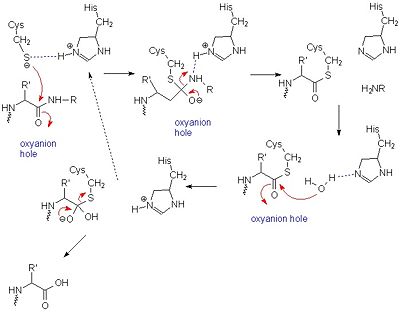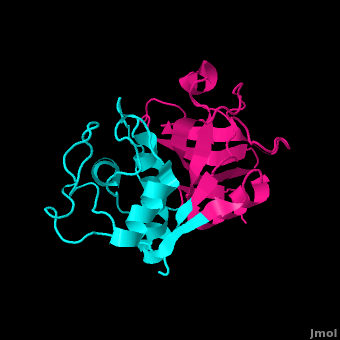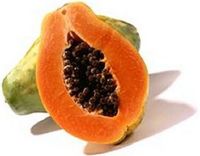Introduction
Papain. Meat tenderizer. Old time home remedy for insect, jellyfish, and stingray stings[2]. Who would have thought that a sulfhydryl protease from the latex of the papaya fruit, Carica papaya and Vasconcellea cundinamarcensis, would have such a practical application beyond Proteopedia?
Papain is a 23.4 kDa, 212 residue cysteine protease, also known as papaya proteinase I, from the peptidase C1 family (E.C. 3.4.22.2).[3][4] It is the natural product of the Papaya(Carica papaya)[5], and may be extracted from the plant's latex, leaves and roots. Papain displays a broad range of functions, acting as an endopeptidase, exopeptidase, amidase, and esterase,[6] with its optimal activity values for pH lying between 6.0 and 7.0, and its optimal temperature for activity is 65 °C. Its pI values are 8.75 and 9.55, and it is best visualized at a wavelength of 278 nm. [5]
Papain's enzymatic use was first discovered in 1873 by G.C. Roy who published his results in the Calcutta Medical Journal in the article, "The Solvent Action of Papaya Juice on Nitrogenous Articles of Food." In 1879, Papain was named officially by Wurtz and Bouchut, who managed to partially purify the product from the sap of papaya. It wasn't until the mid-twentieth century that the complete purification and isolation of Papain was achieved. In 1968, Drenth et al. determined the structure of Papain by x-ray crystallography, making it the second enzyme whose structure was successfully determined by x-ray crystallography. Additionally, Papain was the first cysteine protease to have its structure identified.[6] In 1984, Kamphuis et al. determined the geometry of the active site, and the three-dimensional structure was visualized to a 1.65 Angstrom solution.[7] Today, studies continue on the stability of Papain, involving changes in environmental conditions as well as testing of inhibitors such as phenylmethanesulfonylfluoride (PMSF), TLCK, TPCK, aplh2-macroglobulin, heavy metals, AEBSF, antipain, cystatin, E-64, leupeptin, sulfhydryl binding agents, carbonyl reagents, and alkylating agents.[6]
Papain is synthesised as an inactive precursor with a pro region of 107 residues in the N-terminal[8].
Structure
General Structural Features
Papain is a relatively simple enzyme, consisting of a single 212 residue chain. A majority of papain's residues are as shown in fuchsia. As with all proteins, it is primarily the exclusion of these residues by water that leads to papain's assumption of a globular form. Despite its apparent simplicity and small size, papain folds into two distinct, evenly sized , each with its own (surface residues are transparent, hydrophobic-core residues are colored and opaque, and the remaining are polar, non-surface residues).[7] It is between these two domains that the is situated.
In addition to hydrophobic residues, papain contains a variety of , some carrying a , shown in gray at physiological pH, and are therefore acidic; others a , shown in purple, and are therefore basic. The rest of the , shown in a light gray, are neutral. As expected, the charged face outward due to their hydrophilic nature.
Papain's secondary structure is composed of 21% (45 residues comprising 17 sheets) and 25% (51 residues comprising 7 helices). The rest of the residues, accounting for over 50% of the enzymes structure, make up ordered non-repetative sequences.[9] These secondary structures may be traced from the N- to C-terminus by means of . As shown in this scene, the red end begins the protein at the N-terminus, and can be traced through the colors of the rainbow to the blue end at the C-terminus. These secondary structures form as a result of favorable hydrogen bonding interactions within the polypeptide backbone. Meanwhile, secondary structures are kept in place by hydrophobic interactions and hydrogen bonds between sidechains of adjacent structures.
Intermolecular Forces
strongly contribute to the tertiary structure of papain.[5] In this particular image, clarification of residue coordination is demonstrated by color: paired residues are shown in the same color, oxygen is shown in red, and nitrogen is shown in blue. The tertiary structure of papain is also maintained by three , which connect , , and [4]. These disulfide bonds are likely important in conserving the structural integrity of the enzyme as it operates in extracellular environments at high temperatures. The two subunits, defined above, are held together with , where each protein domain holds the opposite domain. In papain's case the "arm" crossing primarily occurs on or near the surface.[10] The two domains interact with one another via (illustrated with dotted white lines), (shown in white), and (shown as above) in the cleft formed between the two domains. There are several that occur between the two domains, illustrated in orange. The of interactions within the cleft between the two domains ensures that the lobes do not move too much with respect to one another. [11]
Substrate Binding
Papain has a relatively small consisting of three residues: Cys-25, His-159, and Asn-175. The sulfhydryl group on Cys-25 often forms covalent bonds with substrates. His-159 supports Cys-25, and while Arg-175 does not directly participate in the catalytic mechanism, it keeps histidine-159 in its stabilized imidazole form. In addition to the active site, sometimes referred to as the catalytic site, Papain consists of many Subsites are defined as the regions on the enzyme surface which interact with one amino acid residue of the substrate. In the case of Papain, there are seven subsites labeled as follows: S1, S2, S3, S4, located on the amino side of the catalytic site; S1', S2', and S3', located on the carboxyl side of the catalytic site. The binding sites of a substrate are labeled according to how they fit into the binding cleft. P1 associates with S1, P2 with S2, etc. All seven of Papain's subsites hydrogen bond to the corresponding substrate P subsites. The following of Papain have been identified as follows: S1 - His-159; S2 - Trp-177; S3 - Gln-19; S4 - Gly-23; S2' - Asp-158; and S3' - Asp-64. Unfortunately, S1' has yet to be identified.
The seven subsites of Papain have various preferences for substrate residues. Through a variety of experiments, Berger & Schechter[12], were able to show that S1 binds alanine better than glycine, and the larger side chains of lysine, arginine, leucine, and phenylalanine better than alanine. Thus showing that binding in S1 is predominantly hydrophobic. S2 prefers a phenylalanine or a valine residue. Interestingly enough, S2 binds to hydrophobic residues of both short and long peptide chains. They were able to show that subsites S1' and S2' are strongly stereospecific. The conclusion of their research was that Papain's binding site residues show a strong stereospecificity, special interactions, and space limitations.[13]
Catalytic Mechanism
It was once thought that cysteine proteases, like serine proteases, contained a , consisting of Cys-25, His-159, and Arg-175 [14]. However, site-directed mutagenesis-based studies have demonstrated that Arg-175 is not directly involved in catalysis. Although Arg-175 is clearly important for the enzyme's activity (an Arg175Ala mutation reduces its activity to undetectable levels), this residue neither reacts with the substrate nor modulates the pKa of reacting residues, and therefore cannot be considered catalytic.[15][16] Arg-175 is believed to keep histidine-159 in its stabilized imidazole form, while both histidine-159 and cysteine-25 take part in the actual catalytic mechanism.[17] Despite this, the basic mechanism of papain-catalyzed proteolysis proceeds much like that of serine proteases. The mechanism begins when a peptide binds to the active site. Cys-25 is then deprotonated by His-159 and attacks the substrate carbonyl carbon. This forms a covalent, tetrahedral intermediate that is stabilized by an , formed in large part by Gln-19. Next, His-159 acts as a general acid, protonating the nitrogen in the peptide bond, which acts as a leaving group as the carbonyl reforms. This now free C-terminal portion of the peptide is released. Water then enters the active site and attacks the carbonyl carbon while it is deprotonated by His-159, again forming an oxyanion hole-stabilized tetradral covalent intermediate. Finally, the carbonyl reforms and the Cys-25 sulfur acts as a leaving group, releasing the N-terminal portion of the peptide and regenerating the enzyme. This entire mechanism is shown below[18].:

General mechanism of papain catalysis
[17]. Arg-175, which orients His 159, and Gln-19, which contributes to the formation of the oxyanion hole, are not shown.
Inhibitors
Leupeptin
is a commonly studied broad-spectrum competitive protease inhibitor first crystallized by Schröder et. al. It inhibits by binding and interacting with the active site which allows it to block the enzyme's desired protein substrate from binding. There are many that interact with Leupeptin, which are predominantly (shown in blue). These residues include tyrosine, tryptophan, and valine, which coordinate the bound Leuptin. Some of the enzyme's residues also make . These hydrogen bonds, shown in white, include interactions between hydrogens on both Gln-19 and the amide nitrogen of the catalytic Cys-25 with the arginal carbanion, forming the catalytically important oxyanion hole. In addition, Gly-66 interacts with the second leucine in Leupeptin while Asp-158 interacts with a hydrogen on the arginal. These interactions further stabilize and orient the substrate in the binding pocket[19].
A recent study has shown that Leupeptin forms a covalent bond between its and the hydrogen in Cys-25. The inhibitor has the structure Ac-Leu-Leu-Arginal, where Ac is an acetyl group attached to the nitrogen of the first leucine. Cysteine-25, which acts as a catalytic nucleophile, attacks the arginal aldehyde forming a tight-binding transition state from which the normal catalytic mechanism cannot proceed due to this carbonyl having no potential leaving groups bonded to it.
Cathepsin K
The goal of research for the development of an inhibitor for is the hope to develop a treatment for osteoporosis. In two different Cathepsin K inhibitors, , 1bp4, and , 1bqi. 1BP4, N-[(benzyloxy)carbonyl]-L-leucyl-N-[(2S)-1-hydroxy-4-methylpentan-2-yl]-L-leucinamide, inhibits by interacting with on papain: Gln-19, Gly-20, Ser-21, Gly-23, Asn-64, Gly-65, Gln-142, Asp-158, His-159, Trp-177, and Trp-181. These interactions range from hydrophobic, electrostatic, and hydrogen bonding, to , illustrated in blue, between the aromatic ring of the carbobenzyl group on 1BP4, and Trp-177 of papain. The inhibition of papain by IBQI, carbobenzyloxy-(L)-leucinyl-(L)leucinyl methoxymethylketone, is quite similar to that of IBP4, although it does not bind quite as tightly. It binds to of papain: Gln-19, Gly-23, Gly-65, Gln-142, His-159, Trp-177, Trp-181. Additionally, it has similar , shown in blue, between the Cbz ring on the inhibitor and Trp-177.[20]
Cathepsin L
, another inhibitor of Papain, is an endosomal cysteine protease that is believed to have both physiological and pathophysiological effects on the human body. It has been indicated not only in cancer, rhematoid and osteo arthritis, and Alzheimer's, but its mechanism also appears similar to that of Ebola, SARS, Leishmania, malaria, Chagas' disease, African trypanosomiasis, toxoplasmosis, and amoebiasis.[21] Understanding the mechanism of inhibition through the use of papain is therefore crucial to developing treatments for such diseases.[22] Cathepsin L interacts with the Gln-19, Cys-25, Gly-66, Asp-158, and Trp-177 by hydrogen bonding them (Cathepsin L is illustrated in CPK coloring while the interacting sites of Papain are also shown in CPK). In addition to hydrogen bonding, hydrophobic interactions exist to exclude water, allowing the papain enzyme and Cathepsin L to associate even closer.
An interesting inhibitor for Cathepsin L developed using papain as the model protease is that of , 1cvz.[23] It forms a with Cys-25. Five other , labeled in white, are also involved in the bonding of Clik-148 to papain: Gln-19, Gly-66, Asp-158, Trp-177, and Ser-205. These participate in hydrophobic, , and that effectively fill up the cleft between the two domains of papain.[24]
Stefin B
, 1stf acts as a competitive inhibitor to cysteine proteases - it binds tightly but reversibly to the Papain active site. Its interaction is much more complicated than many other cysteine protease inhibitors, such as those illustrated above. Stefin inhibitors are characterized by an Mr of about 11,000, with no disulfide bonds and no associated carbohydrates.
Stefin B consists of five beta sheets wrapped around a five-stranded beta sheet wrapped around a single alpha helix. In Stefin B, the Gly-9 residue along with , illustrated in magenta, form a "wedge" complementary to the active site groove of Papain. This wedge makes extensive and tight interactions with Papain which involves the embedding of 16% of Stefin B into Papain with a total of 128 intermolecular atom-atom interactions occurring. Met-6 - Pro-11, Gln-53 - Asn-59, Gln-101 - His-104, Tyr-124 and Phe-125 on the wedge all have some interaction with the enzyme, though Cys-25 is the only one to form a direct contact. All residues from the base of Stefin B, shown in ball-and-stick form, and both sides of the , shown in gray, are involved in the complex with the inhibitor.
There are a small number of (labeled in , between Stefin B and Papain, however there are many more polar interactions mediated by , the solvent being mainly water. Thirteen solvent molecules of water bridge polar residues of the enzyme and inhibitor. Seventeen hydrogen bonds are made with a solvent molecule and Stefin B. Fourteen of these bridges form a Papain contact. The rest of the interactions are largely hydrophobic-- involving apolar .[25]
Common Uses
Medicinal
Papain has been used for a plethora of medicinal purposes including treating inflammation, shingles, diarrhea, psoriasis, parasites, and many others.[27] One major use is the treatment of cutaneous ulcers including diabetic ulcers and pressure ulcers. Pressures ulcers plague many bed bound individuals and are a major source of pain and discomfort. Two papain based topical drugs are Accuzyme and Panafil, which can be used to treat wounds like cutaneous ulcers.[28]
A recent New York Times article featured papain and other digestive enzymes. With the number of individuals suffering from irritable bowel syndrome and other gastrointestinal issues, many people are turning toward natural digestive aid supplements like papain. The author even talks about the use of papain along with a pineapple enzyme, bromelain, in cosmetic facial masks. Dr. Adam R. Kolker (a plastic surgeon) is quoted in the article saying that "For skin that is sensitive, enzymes are wonderful." He bases these claims off the idea that proteases like papain help to break peptide bonds holding dead skin cells to the live skin cells.[29]
Commercial and Biomedical
Papain digests most proteins, often more extensively than pancreatic proteases. It has a very broad specificity and is known to cleave peptide bonds of basic amino acids and leucine and glycine residues, but prefers amino acids with large hydrophobic side chains. This non-specific nature of papain's hydrolase activity has led to its use in many and varied commercial products. It is often used as a meat tenderizer because it can hydrolyze the peptide bonds of collagen, elastin, and actomyosin. It is also used in contact lens solution to remove protein deposits on the lenses and marketed as a digestive supplement. [27]
Despite a low percentage of sequence identities, inhibition and sequence analyses have increasingly been drawing parallels between L proteinases, that involve the foot-and-mouth disease virus and equine rhinovirus 1, and papain. With a similar overall fold to papain and identifiable regions that resemble papain's five alpha-helices and seven beta-sheets, L proteinases of foot-and-mouth disease virus and of equine rhinovirus 1 reveal a mode of operation that is very papain-like.[30]




